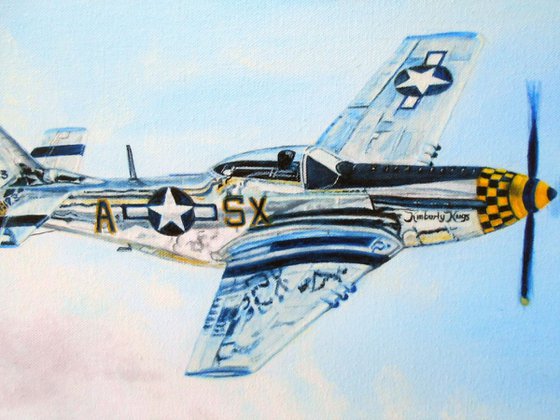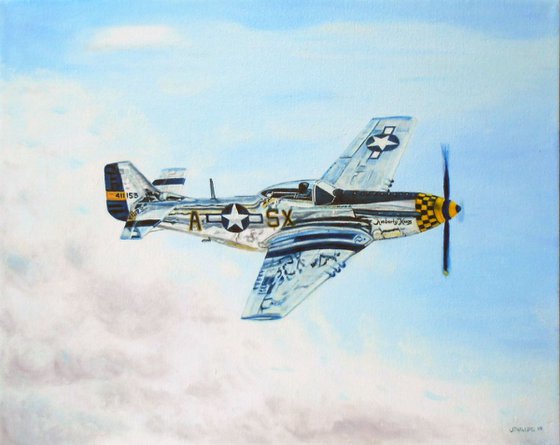- By medium
- By subject
- By budget
- Sales
- Gift cards
- Discover all art
- Artists
- Editors’ picks
- Ideas
Original artwork description:
North American P-51 Mustang
Generally considered the best fighter of WWI!
By Stephen Sherman, Apr. 2002. Updated Sept. 26, 2012.
North American Aviation originally designed the Mustang in response to a British specification. They agreed to produce the first prototype only 4 months after signing the contract in April 1940.
By the end of 1941 North American had delivered the first Mustang to England for test flights. These first Mustangs were powered by the Allison V-1710 engine, a good engine, but one which didn't operate well at high altitudes.
A Better Engine
In April, 1942, a British test pilot, Ronald Harker, flew the Mustang and was very impressed by it. He suggested that the new plane would be a natural fit with the Rolls Royce Merlin 60-series engine, well-suited to high altitudes. At the prodding of Major Thomas Hitchcock, the Americans began working along the same lines (using the Packard license-built version of the Merlin), and the first Merlin-equipped Mustang, the P-51B, flew in November, 1942. The results were impressive, to say the least. At 30,000 feet, the improved Mustang reached 440 MPH, almost 100 MPH faster than the Allison-equipped Mustang at that altitude.
The Artist painted this from a photo and was inspired to capture the reflective qualities on the planes surface.
Materials used:
Oil
Tags:
#north american barns #world war ii fighter #plane #fighters #mustang #p51Featured by our Editors:
P 51 in Flight (2015)
Oil painting
by Jeffrey Allen Phillips - My JP Art
£836.85
- Oil painting on Canvas
- One of a kind artwork
- Size: 50.8 x 40.64 x 2.54cm (unframed) / 53.34 x 43.18cm (actual image size)
- Ready to hang
- Signed on the front
- Style: Photorealistic
- Subject: Transportation and maps
Original artwork description
North American P-51 Mustang
Generally considered the best fighter of WWI!
By Stephen Sherman, Apr. 2002. Updated Sept. 26, 2012.
North American Aviation originally designed the Mustang in response to a British specification. They agreed to produce the first prototype only 4 months after signing the contract in April 1940.
By the end of 1941 North American had delivered the first Mustang to England for test flights. These first Mustangs were powered by the Allison V-1710 engine, a good engine, but one which didn't operate well at high altitudes.
A Better Engine
In April, 1942, a British test pilot, Ronald Harker, flew the Mustang and was very impressed by it. He suggested that the new plane would be a natural fit with the Rolls Royce Merlin 60-series engine, well-suited to high altitudes. At the prodding of Major Thomas Hitchcock, the Americans began working along the same lines (using the Packard license-built version of the Merlin), and the first Merlin-equipped Mustang, the P-51B, flew in November, 1942. The results were impressive, to say the least. At 30,000 feet, the improved Mustang reached 440 MPH, almost 100 MPH faster than the Allison-equipped Mustang at that altitude.
The Artist painted this from a photo and was inspired to capture the reflective qualities on the planes surface.
Materials used:
Oil
Tags:
#north american barns #world war ii fighter #plane #fighters #mustang #p51Featured by our Editors:
Returns and refunds
We want you to love your art! If you are not completely satisfied with your purchase you can return it free within 14 days, no questions asked. Learn more
This artwork is sold by Jeffrey Allen Phillips - My JP Art from United States




